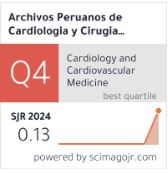Síndrome de Bayés, accidente cerebrovascular y demencia
DOI:
https://doi.org/10.47487/apcyccv.v2i1.126Palabras clave:
síndrome de Bayés, bloqueo interatrial, fenómenos tromboembólicos, accidente cerebrovascular, demencia, anticoagulaci´ónResumen
El síndrome de Bayés es una entidad clínica que se define como la asociación entre la presencia de bloqueo interauricular avanzado (BIA-A), y el desarrollo de taquiarritmias supraventriculares (TSV), siendo la fibrilación auricular (FA), la más frecuente. Esta asociación salió a la luz con los estudios del Prof. Antoni Bayés de Luna en los años ‘80. Estudios realizados posteriormente por otros grupos encontraron una fuerte asociación entre este síndrome y la ocurrencia de fenómenos tromboembólicos, siendo el accidente cerebrovascular (ACV) el más grave. Del mismo modo, se documentó una asociación con deterioro cognitivo y demencia. Esto generó la pregunta acerca de si la terapia de anticoagulación previa a la documentación de FA podría prevenir la ocurrencia de tromboembolismos asociados al BIA-A y de esta manera preservar el estado cognitivo. Esta pregunta permanece, aún hoy, sin respuesta definitiva. Existen estudios en diferentes estadios de su desarrollo cuyo objetivo es comparar la efectividad de la anticoagulación en pacientes con BIA-A y sin FA documentada. Los resultados de los mismos permitirán establecer la efectividad de esta opción terapéutica temprana y, de manera conclusiva, definir si, para decidir anticoagular un paciente, la FA tiene que ser previamente documentada o no.
Descargas
Referencias
Conde D, Seoane L, Gysel M et al. Bayes syndrome: the association between interatrial block and supraventricular arrhythmias; Expert Rev Cardiovasc Ther. 2015; 13(5): 541-55. DOI: https://doi.org/10.1586/14779072.2015.1037283
Conde D, Baranchuk A. Bloqueo interauricular como sustrato anatómico-eléctrico de arritmias supraventriculares: Síndrome de Bayés; Arch. Cardiol. Mex.; 2014; 84(1): 32-40. DOI: https://doi.org/10.1016/j.acmx.2013.10.004
Baranchuk A. Síndrome de Bayés. Valor del electrocardiograma en la predicción de fibrilación auricular. Rev Urug Cardiol. [Internet]. 2015 Dec [cited 2021 Mar 03]; 30(3):404-410. Available from: http://www.scielo.edu.uy/scielo.php?script=sci_arttext&pid=S1688-04202015000300018&lng=en
Conde D, Baranchuk A. Síndrome de Bayés: lo que un cardiólogo no debe dejar de saber. Rev Argent Cardiol. 2014; 82: 237 – 239. DOI: http://dx.doi.org/10.7775/rac.es.v82.i3.3862
Iomini PA, Baranchuk A, Bayés de Luna A. Síndrome de Bayés: aspectos fundamentales, implicancias clínicas y perspectivas futuras. Rev. CONAREC, 2021(In Press).
Bayés de Luna A, Fort De Ribot R, Tiulla E, Julia J et al. Electrocardiography and vectocardiography study of interatrial conduction disturbances with left atrial retrograde activation; J electrocardiol. 1985; 18 (1): 1-14. DOI: https://doi.org/10.1016/s0022-0736(85)80029-7
Bayés de Luna A, Cladellas M, Oter R, et al. Interatrial conduction block and retrograde activation of the left atrium and paroxysmal supraventricular tachyarrhythmia. Eur Heart J. 1988; 9: 1112-1118. DOI: https://doi.org/10.1093/oxfordjournals.eurheartj.a062407
Chhabra L, Devadoss R, Chaubey V et al. Interatrial block in the modern era. Curr Cardiol Rev. 2014; 10(3): 181 – 189. DOI: https://doi.org/10.2174/1573403x10666140514101748
Bayés de Luna A, Baranchuk A, Escobar Robledo L, et al. Diagnosis of interatrial block. J Geriatr. Cardiol. 2017; 14: 161 – 165. DOI: https://dx.doi.org/10.11909%2Fj.issn.1671-5411.2017.03.007
Bisbal F, Baranchuk A, Braunwald E, et al. Atrial failure as a clinical entity: Review Topic of the Week. JACC. 2020; 75 (2): 222-232. DOI: https://doi.org/10.1016/j.jacc.2019.11.013
Martínez-Sellés M, Elosua R, Ibarrola M, et al. Advanced interatrial block and P-wave duration are associated with atrial fibrillation and stroke in older adults with heart disease: the BAYES registry. Europace. 2020; 22: 1001-1008. DOI:10.1093/europace/euaa114
Baranchuk A, Alexander B, Cinier G, et al. Bayés’s syndrome: Time to consider early anticoagulation? North Clin Istanb. 2018; 5 (4): 370-378. DOI: https://dx.doi.org/10.14744%2Fnci.2017.60251
King J, Azadani P, Suksaranjit P, et al. Left atrium fibrosis and risk for cerebrovascular and cardiovascular events in patients with atrial fibrillation. JACC. 2017; 70(11): 1311-21. DOI: https://doi.org/10.1016/j.jacc.2017.07.758
Bayés de Luna A, Platonov P, Cosio F, et al. Interatrial blocks. A separate entity from left atrial enlargement: a consensus report. J Electrocardiol. 2012; 45: 445-451. DOI: 10.1016/j.jelectrocard.2012.06.029.
Bayés de Luna A, Baranchuk A, Escobar Robledo L, et al. Diagnosis of interatrial block. J Geriatr Cardiol. 2017; 14: 161 – 165. DOI: https://dx.doi.org/10.11909%2Fj.issn.1671-5411.2017.03.007
Bayés de Luna A, Baranchuk A, Niño Pulido C, et al. Second degree interatrial block: brief review and concept. Ann Noninvasive Electrocardiol. 2018; 23: e12583. DOI: 10.1111/anec.12583
Enriquez A, Marano M, D'Amato A, et al. Second-degree interatrial block in hemodialysis patients. Case Rep Cardiol. 2015; 468493. DOI: https://dx.doi.org/10.1155%2F2015%2F468493
Bayés de Luna A, Escobar-Robledo LA, Aristizabal D, et al. Atypical advanced interatrial block: definition and electrocardiographic recognition. J Electrocardiol. 2018; 51: 1091-1093. DOI: 10.1016/j.jelectrocard.2018.09.004
Ariyarajah V, Apiyasawat S, Najjar H, et al. Frequency of interatrial block in patients with sinus rhythm hospitalized for stroke and comparison to those without interatrial block. Am J Cardiol. 2007; 99: 49-52. DOI: 10.1016/j.amjcard.2006.07.060
Ariyarajah V, Puri P, Apiyasawat S, et al. Interatrial block: a novel risk factor for embolic stroke? Ann Noninvasive Electrocardiol. 2007; 12: 15-20. DOI: https://doi.org/10.1111/j.1542-474x.2007.00133.x
Lorbar M, Levrault R, Phadke JG, et al. Interatrial block as a predictor of embolic stroke. Am J Cardiol. 2005; 95: 667–8. DOI: 10.1016/j.amjcard.2004.10.059
Cotter PE, Martin PJ, Pugh PJ, et al. Increased incidence of interatrial block in younger adults with cryptogenic stroke and patent foramen ovale. Cerebrovasc Dis Extra. 2011; 1: 36–4. DOI: 10.1159/000327346
O’Neal W, Kamel H, Zhang ZM, et al. Advanced interatrial block and ischemic stroke; Neurology. 2016; 87: 352–356. DOI: https://dx.doi.org/10.1212%2FWNL.0000000000002888
Martínez-Sellés M, Massó-van Roessel A, Álvarez-García J, et al. Interatrial block and atrial arrhythmias in centenarians: Prevalence, associations, and clinical implications. Heart Rhythm. 2016; 13: 645–51. DOI: 10.1016/j.hrthm.2015.10.034
Lindow T, Baranchuk A. Interatrial block and ischemic stroke. J Thorac Dis. 2018; 10 (12): 7052-7054. DOI: 10.21037/jtd.2018.11.23
Bayés de Luna A, Martínez-Sellés M, Bayés-Genís A, et al. Síndrome de Bayés. Lo que todo clínico debe conocer. Rev Esp Cardiol. 2020; 73: 758-762. DOI: https://doi.org/10.1016/j.recesp.2020.04.003
Carrillo-Loza K, Baranchuk A, Serrano F, et al. El bloqueo interatrial avanzado predice recurrencia de infarto cerebral embólico de origen no determinado. Neurología. 2019. DOI: https://doi.org/10.1016/j.nrl.2019.10.007
Çinier G, Tekkeşin A, Çelik TY et al. Value of Interatrial Block for the Prediction of Silent Ischemic Brain Lesions. JAFIB. 2018; 11 (3): 1 – 5. DOI: https://dx.doi.org/10.4022%2Fjafib.2037
Wang Z, Qin H, Chen G, et al. Association between advanced interatrial block and small vessel diseases in the brain. Quant Imaging Med Surg. 2020; 10 (3):585-591. DOI: 10.21037/qims.2020.02.02.
Martínez-Sellés M, Martínez-Larrú ME, Ibarrola M, et al. Interatrial block and cognitive impairment in the BAYES prospective registry. International Journal of Cardiology, 2020, vol. 321: 95–98. DOI: 10.1016/j.ijcard.2020.08.006
Herrera C, Bruña V, Abizanda P, et al. Relation of Interatrial Block to Cognitive Impairment in Patients ≥ 70 Years of Age (From the CAMBIAD Case-control Study). Am J Cardiol. 2020; 136: 94-99. DOI: 10.1016/j.amjcard.2020.09.008.
Spodick DH, Ariyarajah V. Interatrial block: the pandemic remains poorly perceived. PACE. 2009; 32: 667-672. DOI: 10.1111/j.1540-8159.2009.02343.x.
Martínez-Sellés M. Prevalence and incidence of interatrial block in global population and in different clinical situations. J Geriatr Cardiol. 2017; 14: 158–60. DOI: https://dx.doi.org/10.11909%2Fj.issn.1671-5411.2017.03.006
Jairath UC, Spodick DH. Exceptional prevalence of interatrial block in a general hospital population. Clin Cardiol. 2001; 24(8): 548 - 50. DOI: https://doi.org/10.1002/clc.4960240805
Assad N, Spodick D. Prevalence of interatrial block in a general hospital population. Am J Card. 2003; 91: 609-610. DOI: 10.1016/s0002-9149(02)03320-9
O’Neal WT, Zhang ZM, Loehr LR, et al. Electrocardiographic advanced interatrial block and atrial fibrillation risk in the general population. Am J Cardiol. 2016: 117 (11): 1755–1759. DOI: 10.1016/j.amjcard.2016.03.013
Nielsen JB, Kühl JT, Pietersen A, et al. P-wave duration and the risk of atrial fibrillation: Results from the Copenhagen ECG Study. Heart Rhythm. 2015; 12: 1887–95. DOI: 10.1016/j.hrthm.2015.04.026
Hernández-Betancor I, Izquierdo-Gómez MM, Garcia-Niebla J, et al. Bayés’s syndrome and imaging techniques. Cur Cardio rev. 2017; 13: 263 -273. DOI: https://dx.doi.org/10.2174%2F1573403X13666170713122600
Lacalzada-Almeida J, García-Niebla J. How to detect atrial fibrosis. J Geriatr Cardiol. 2017; 14:185-194. DOI: https://dx.doi.org/10.11909%2Fj.issn.1671-5411.2017.03.008
Benito EM, Bayés de Luna A, Baranchuk A, et al. Extensive atrial fibrosis assessed by late gadolinium enhancement cardiovascular magnetic resonance associated with advanced interatrial block electrocardiogram pattern. Europace. 2017; 19 (3): 377. DOI:10.1093/europace/euw294
Ciuffo L, Bruña V, Martínez-Sellés M, et al. Association between interatrial block, left atrial fibrosis, and mechanical dyssynchrony: Electrocardiography-magnetic resonance imaging correlation. J Cardiovasc Electrophysiol. 2020; 31 (7): 1719 - 1725. DOI: 10.1111/jce.14608.
Wu JT, Wang SL, Chu YJ, et al. CHADS2 and CHA2DS2-VASc scores predict the risk of ischemic stroke outcome in patients with interatrial block without atrial fibrillation. J Atheroscler Thromb. 2017; 24: 176-184. DOI: https://dx.doi.org/10.5551%2Fjat.34900
Baturova MA, Lindgren A, Shubik YV, et al. Interatrial block in prediction of all-cause mortality after first-ever ischemic stroke. BMC Cardiovasc Disord. 2019; 19: 37. DOI: https://doi.org/10.1186/s12872-019-1015-5
Bayés de Luna A, Baranchuk A, Martínez-Sellés M, et al. Anticoagulation in patients at high risk of stroke without documented atrial fibrillation: time for a paradigm shift? Ann. Noninvasive Electrocardiol. 2017; 22: e12417. DOI: https://dx.doi.org/10.1111%2Fanec.12417
Bayés de Luna A, Martínez-Sellés M, Bayés-Genís A, et al. Surfaced ECG interatrial block-guided treatment for stroke prevention: rationale for an attractive hypothesis. BMC Cardiovascular Disorders. 2017; 17: 211. DOI: https://dx.doi.org/10.1186%2Fs12872-017-0650-y
Baranchuk A, Torner P, Bayés-de-Luna. Bayés Syndrome: What Is It? Circulation. 2018; 137 (2):200-202. DOI: 10.1161/CIRCULATIONAHA.117.032333.
Kamel H, Longstreth WT Jr, Tirschwell DL, et al. The AtRial Cardiopathy and Antithrombotic Drugs in Prevention After cryptogenic stroke randomized trial: Rationale and methods. Int J Stroke. 2019; 14(2): 207-214. DOI: 10.1177/1747493018799981.


















